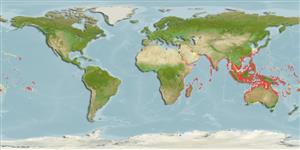Issue
Genetic data indicate the presence of cryptic species with partial parapatric distribution. The species Paniliza macrolepis may be limited to West Indian Ocean lineages (Durand & Borsa (2015: Ref. 114224).
Environment: milieu / climate zone / depth range / distribution range
Ökologie
seewasser; süßwasser; brackwasser demersal; katadrom (Ref. 46888); tiefenbereich 10 - ? m (Ref. 40448). Tropical; 32°N - 35°S, 22°E - 136°W
Indo-Pacific: east coast of Africa, south to Eastern Cape in South Africa (Ref. 52193), including Madagascar, Seychelles, Rodriguez; north to Sri Lanka and India (except Bay of Bengal), Andaman and Nicobar Islands, east to Indonesia, China, the Philippines, Japan, Marshall and Tuamoto islands, Melanesia and Polynesia (Ref. 2830). Distribution includes the Red Sea (Ref. 84159) and Persian Gulf (Ref. 66734).
Length at first maturity / Size / Gewicht / Alter
Maturity: Lm 23.0 range ? - ? cm
Max length : 60.0 cm SL Männchen/unbestimmt; (Ref. 4967); common length : 26.0 cm SL Männchen/unbestimmt; (Ref. 4967); max. veröff. Alter: 6 Jahre (Ref. 127264)
Rückenflossenstacheln (insgesamt) : 4 - 5; Rückenflossenweichstrahlen (insgesamt) : 8 - 9; Afterflossenstacheln: 3; Afterflossenweichstrahlen: 8 - 10.
Occur in shallow coastal waters, and from brackish water to freshwater regions of rivers (Ref. 41299). Form schools (Ref. 40448); in larger aggregations during spawning, which takes place at sea (Ref. 2830). Feed on small algae, diatoms, forams, benthic polychaetes, crustaceans, mollusks, organic matter and detritus; fry feed on copepods and floating algae (Ref. 40448). Oviparous, eggs are pelagic and non-adhesive (Ref. 205). Caught mainly during the spawning season and is sold fresh; the roe is highly appreciated.
Nakabo, T., 2002. Fishes of Japan with pictorial keys to the species, English edition I. Tokai University Press, Japan, pp v-866. (Ref. 41299)
IUCN Rote Liste Status (Ref. 130435)
Bedrohung für Menschen
Harmless
Nutzung durch Menschen
Fischereien: kommerziell; Aquakultur: kommerziell; Sportfisch: ja
Tools
Zusatzinformationen
Download XML
Internet Quellen
Estimates based on models
Preferred temperature (Ref.
123201): 24.5 - 29, mean 28 °C (based on 810 cells).
Phylogenetic diversity index (Ref.
82804): PD
50 = 0.5078 [Uniqueness, from 0.5 = low to 2.0 = high].
Bayesian length-weight: a=0.01288 (0.01051 - 0.01579), b=2.93 (2.90 - 2.96), in cm total length, based on LWR estimates for this species (Ref.
93245).
Trophic level (Ref.
69278): 2.8 ±0.17 se; based on food items.
Widerstandsfähigkeit (Ref.
120179): niedrig, Verdopplung der Population dauert 4,5 - 14 Jahre. (K=0.10).
Fishing Vulnerability (Ref.
59153): Moderate to high vulnerability (49 of 100).
Nutrients (Ref.
124155): Calcium = 138 [59, 322] mg/100g; Iron = 1.09 [0.51, 2.31] mg/100g; Protein = 18.3 [16.5, 20.0] %; Omega3 = 0.25 [0.12, 0.56] g/100g; Selenium = 38.3 [18.7, 89.9] μg/100g; VitaminA = 17.7 [4.8, 58.4] μg/100g; Zinc = 1.69 [1.14, 2.55] mg/100g (wet weight);
